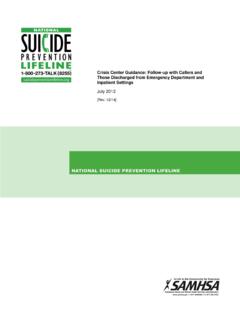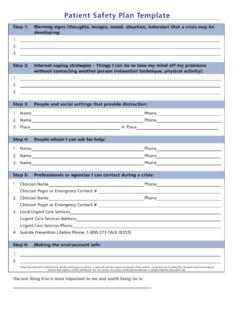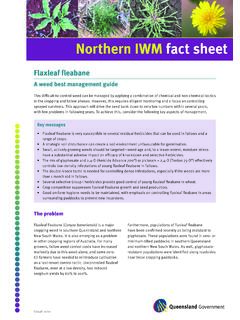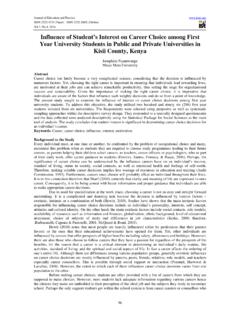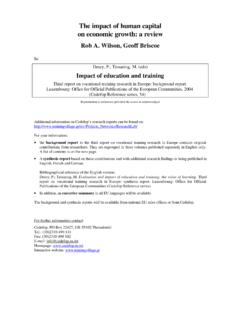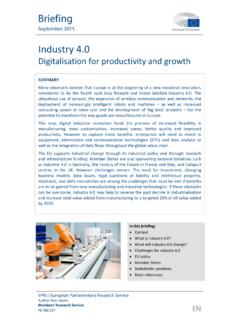Transcription of CALL CENTER METRICS
1 CRISISMETRICS PART 1: SERVICE AND EFFICIENCYCALL CENTER EXECUTIVE SUMMARY .. 1 BACKGROUND & SIGNIFICANCE .. 5 National Suicide Prevention Lifeline .. 5 The Need for Standard Measures .. 5 CRISIS CALL CENTERS .. 8 General Call CENTER Functions .. 8 Automated Call Distribution Systems (ACD) .. 9 About Crisis Call CENTER Benchmarks .. 11 Related Industry Standards .. 12 KEY PERFORMANCE INDICATORS (KPIs) .. 15 Service Measures (SM) .. 16 Accessibility: Blockage (SM-1) .. 16 Accessibility: Hours of Operation (SM-2) .. 17 Accessibility: Self Service Availability (SM-3) .. 17 Accessibility: Call Abandonment Rate (SM-4) .. 19 Speed of Service: Service Level (SM-5).
2 21 Speed of Service: Average Speed of Answer (SM-6) .. 33 Speed of Service: Longest Delay in Queue (SM-7) .. 35 Efficiency Measures (EM) .. 35 Contact Handling: Average Handle Time (EM-1) .. 36 Contact Handling: After-Call Work Time (EM-2) .. 37 Contact Handling: On Hold Time (EM-3) .. 38 Resource Utilization: Staff Occupancy (EM-4) .. 38 Resource Utilization: Staff Shrinkage (EM-5) .. 39 Resource Utilization: Schedule Efficiency (EM-6) .. 40 Resource Utilization: Schedule Adherence (EM-7) .. 40 Cost Efficiency: Cost per Call (EM-8) .. 42 TABLE OF CONTENTSOPTIMIZING CRISIS CENTER OPERATIONS .. 46 Managing Workforce .. 48 Enhancing Service Levels.
3 49 APPENDIX A: Workforce Management .. 54 Five Steps in Workforce Management Planning .. 54 The Importance of Accurate Forecasting .. 55 APPENDIX B: Erlang B and Erlang C .. 57 APPENDIX C: Staffing Patterns and Service Levels .. 61 The Power of One .. 61 The Power of Pooling .. 64 APPENDIX D: Hidden CENTER Costs .. 65 The Cost of Wait Time .. 65 The Real Cost of Staff Attrition .. 66 REFERENCES .. 68 TABLE OF CONTENTS (CONT .)Special thanks to the following individuals who participated in the Crisis Call CENTER METRICS Workgroup (November 2016 December 2017) and who contributed their time and expertise to the development and editing of this document.
4 Andy Brown Executive Director, Headquarters Counseling CENTER Anitha Iyer Chief Clinical Officer / Vice President, Crisis and Behavioral Health Technologies, Mental Health Association of NYCBart Andrews Vice President of Clinical Operations, Behavioral Health ResponseDavid Bond Vice President of Programs, The Trevor Project Gillian Murphy Director of Standards, Training and Practices, National Suicide Prevention LifelineJennifer Battle Program Director, The Harris CENTER for Mental Health and IDDJohn Draper Project Director, National Suicide Prevention LifelineKimberly Mullen Quality Assurance Officer, Clinical Psychologist, Veterans Crisis LineMatt Taylor Network Development Manager, National Suicide Prevention LifelineMolly Brack Director, Agora Crisis CenterPhil Evans President/CEO, ProtoCall ServicesShari Sinwelski Associate Project Director, National Suicide Prevention LifelineShelby Rowe Manager of Education and Prevention Programs, American Foundation for Suicide PreventionShye Louis Best Practices Coordinator, National Suicide Prevention LifelineTim Jansen Executive Director, Community Crisis ServicesWendy Farmer CEO, Behavioral Health LinkNOTE: The purpose of this document is to summarize available information on call CENTER METRICS .
5 Throughout the document various sections have been taken directly (or adapted) from online sources. These sections are indicated and links provided to original text. CREDITSIn an effort to address the lack of formal standards for crisis call CENTER METRICS , the National Suicide Prevention Lifeline (Lifeline) set about gathering available and relevant information for use in determining benchmarks for the industry. This paper was developed for crisis call CENTER managers to reference and should be viewed as a first step in establishing common definitions for service provision that will facilitate data sharing. It is also intended for crisis CENTER funders to be used as a point of reference in the establishment of realistic performance measures.
6 It is important to note that crisis call centers are not providing a service comparable to technical support lines or sales call centers and cannot be held to standards of operation reflective of these industries. Call CENTER development, and ultimate success, is a science based endeavor. Entire businesses have been established in the pursuit of how to effectively manage and grow such enterprises within a rapidly changing technical environment. Effectively addressing the needs of callers, particularly those experiencing a mental health crisis, while maintaining a viable workforce is mission-critical and crisis call centers, such as suicide hotlines, add another immeasurable element to the equation: outcome measures that directly impact lives.
7 As a manager, community stakeholder, or potential funder, there are several essential elements of a crisis call CENTER that must be understood before decisions regarding operations planning, outcomes, or funding can be made (see particularly Optimizing Crisis CENTER Operations and Appendices for detail). The following points, outlined by the International Customer Management Institute (ICMI) (2010), are considered here in the context of a Lifeline crisis call CENTER , and discussed further throughout this paper in greater detail. EXECUTIVE SUMMARY12 Call centers are extremely complex and dynamic and no standard operating procedure will apply universally to all centers.
8 Crisis call centers, in particular, bear limited resemblance to generalized call centers and generating requirements based on operating procedures and outcome measures from non-crisis call centers can prove to be grossly inappropriate. Crisis hotlines, perhaps more than any other call CENTER business, experience significant variability in terms of call volume, caller needs, and potential interventions, making staffing (and therefore cost) projections challenging. Calls could range from basic information and referral needs, to crisis counseling and de-escalation of severe distress, to an active rescue where two staff may be required to locate a caller at imminent risk of suicide, coordinate emergency services and transportation, support the caller, and follow-up to ensure safety.
9 In situations where centers have only one or two staff members available in a given hour, longer calls can significantly impact capacity to respond to additional incoming calls. Such challenges must be considered in setting service levels METRICS . There is generally no call CENTER industry standard for accessibility . Naturally, there is a desire that callers not wait excessively long for service. What is considered too long, or even appropriate or tolerable wait times for callers? For hotline callers, the very term suggests that callers are in a situation that requires a rapid response. However, the assumption that callers cannot wait has enormous (and expensive) resource implications that must be addressed to satisfy these expectations.
10 From our review of call CENTER industries, no single service level or response time objective makes sense for every call CENTER . Different centers will have different costs, types of callers and local service objectives. Despite this, many funders will apply general METRICS to all industries an example being, answer all calls within 30 seconds or less or answer 80% of calls within 20 seconds or less, but where did this come from? There is no evidence to support what is known as the 80/20 rule and there is no evidence, even for hotline callers, that the great majority of those in crisis will not be able to tolerate a wait longer than 20 seconds for their call to be answered.


